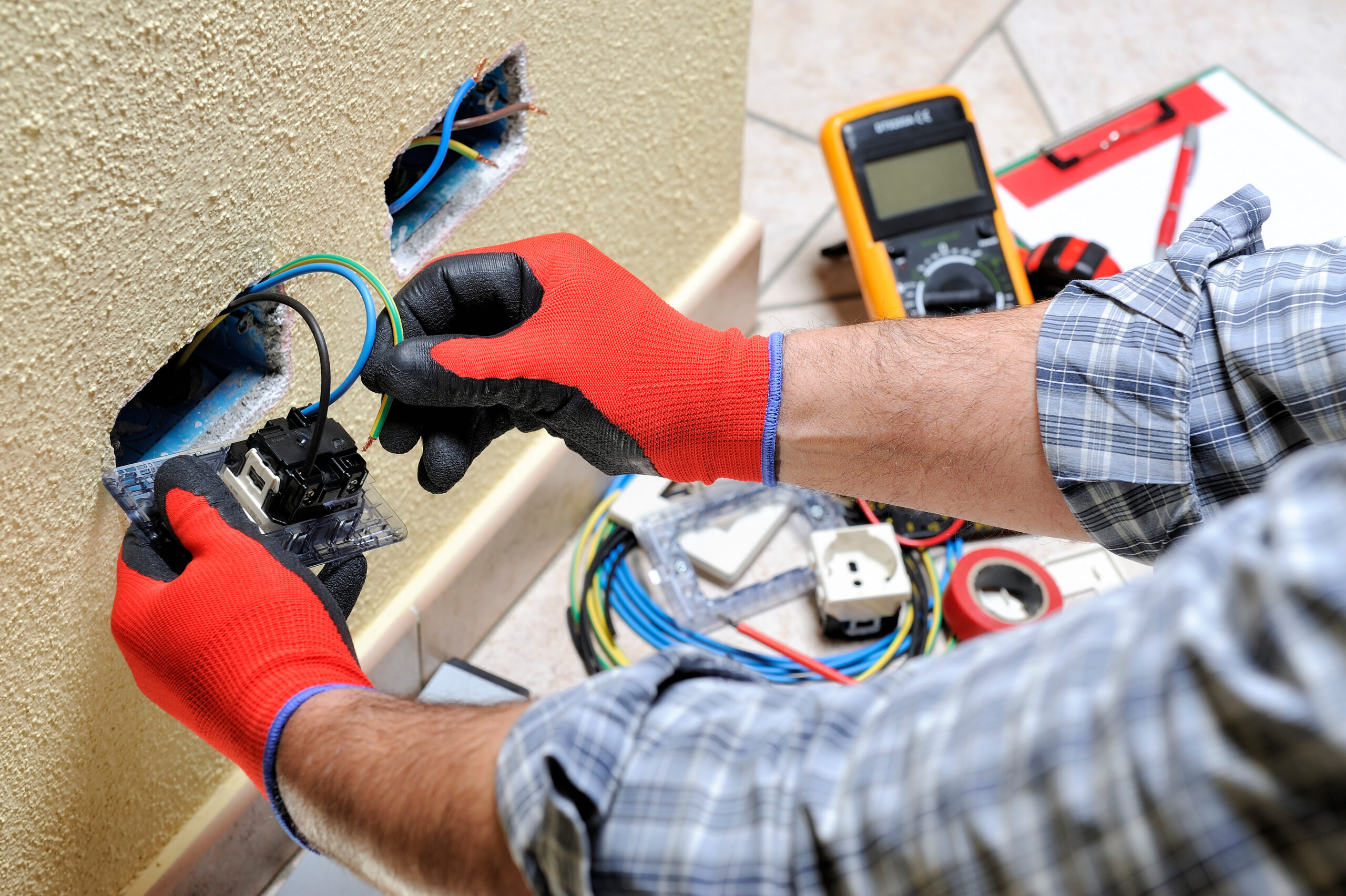Workplace safety is an important aspect of understanding for electricians. Our modern world thrives on the invisible power of electricity. It illuminates our homes, fuels our industries, and connects us globally. However, this convenience comes at a cost. Working with electricity inherently carries significant dangers. A seemingly simple mistake can result in a severe electrical shock, a devastating arc flash explosion, or a potentially lethal electrical fire. The consequences can be far-reaching, impacting not just the electrician but also colleagues and bystanders.
This is where prioritizing safety becomes paramount. While completing electrical work efficiently is important, ensuring the safety of yourself and others should always be the top priority. This comprehensive guide aims to equip electricians with the knowledge and best practices to navigate the electrical world safely and effectively. By adopting a safety-first approach, we can cultivate a positive work environment where productivity thrives alongside well-being.
This is where prioritizing safety becomes paramount. While completing electrical work efficiently is important, ensuring the safety of yourself and others should always be the top priority. This comprehensive guide aims to equip electricians with the knowledge and best practices to navigate the electrical world safely and effectively. By adopting a safety-first approach, we can cultivate a positive work environment where productivity thrives alongside well-being.
Understanding Electrical Hazards
Electricians navigate a complex world of invisible energy, and understanding the potential dangers lurking within is crucial for workplace safety. This section will equip you with the knowledge to identify and mitigate the most common electrical hazards encountered in the field.
Types of Electrical Hazards
Lorem Ipsum has been the industry's standard dummy text ever since the 1500s, when an unknown printer took a galley of type and scrambled it to make a type specimen book.
- Electric Shock: This occurs when an uncontrolled electrical current passes through the human body. The severity of a shock depends on several factors:
- Current Strength: Measured in amperes (amps), higher current creates a greater risk of severe injury or death.
- Path of Current: The path the current takes through the body. Muscle contractions can occur, hindering attempts to break free from the current source. If the current path disrupts the heart's rhythm, it can lead to cardiac arrest.
- Duration of Contact: The longer the contact with the current source, the more severe the potential injury.
- Arc Flash: An arc flash is a sudden, intense burst of light and heat caused by an electrical short circuit. This short circuit creates a plasma arc with temperatures reaching thousands of degrees Celsius. The dangers of an arc flash are twofold:
- Thermal Burns: The extreme heat can cause severe burns on exposed skin, even through clothing.
- Arc Blast: The short circuit can generate a powerful pressure wave capable of throwing workers and causing blunt force trauma.
- Electrical Fires: Faulty wiring, overloaded circuits, and improper use of electrical equipment can all lead to electrical fires. These fires pose a significant threat to life and property due to:
- Smoke Inhalation: Electrical fires often produce thick smoke that can cause respiratory problems and disorientation.
- Property Damage: Electrical fires can quickly engulf structures and cause significant damage.
Identifying Electrical Hazards:
A critical skill for electricians is recognizing potential hazards before they cause harm. Here are some key areas to focus on:
- Damaged or Exposed Wiring: Look for frayed, cracked, or melted insulation on wires. Exposed wires pose a direct risk of electrical shock.
- Overloaded Circuits: Signs of overloaded circuits include tripping breakers or flickering lights. Overloaded circuits can overheat and ignite surrounding materials.
- Arc Flash Hazards: Pay attention to equipment labels that indicate potential arc flash risks. Additionally, investigate past incidents of arc flashes within the workspace to identify areas of high risk.
Safe Work Practices: Your Shield Against Electrical Hazards
The electrical world may hold inherent dangers, but by adopting safe work practices, electricians can significantly reduce the risk of accidents. This section will equip you with the tools and knowledge to navigate the workplace safely and effectively.
Personal Protective Equipment (PPE)
PPE acts as your first line of defense against electrical hazards. Here's how to ensure it provides optimal protection:
- Choosing the Right PPE: The level of PPE required depends on the specific job and potential hazards. It can include:
- Insulated Gloves: Rated for the voltage you'll be working with.
- Safety Glasses: Protect your eyes from flying debris and arc flash radiation.
- Arc-Flash Suit: Provides flame-resistant protection during high-risk activities.
- Selection Criteria: Don't settle for generic PPE. Ensure it meets relevant safety standards, such as ASTM International (ASTM) or the National Fire Protection Association (NFPA).
- Proper Care and Inspection: Regularly inspect your PPE for damage, cracks, or tears. Replace worn-out equipment to maintain its effectiveness. Remember, compromised PPE can be worse than no protection at all.
Lockout/Tagout (LOTO) Procedures
LOTO procedures are essential for ensuring the safe isolation of energized electrical equipment before performing maintenance or repairs. Here's a breakdown of the process:
- Shutting Down: Disconnect the power source using an appropriate isolating switch or breaker.
- Locking/Tagging: Lock the isolating device to prevent accidental energization. Additionally, attach a tag clearly stating that the equipment is locked out and work is in progress.
- Verification: Before starting work, verify that the equipment is de-energized using a voltage tester. This double-check ensures no residual current is present.
- Clear Communication: LOTO procedures often involve multiple workers. Clear and concise communication is crucial to ensure everyone involved understands the process and potential hazards.
Grounding
Grounding plays a vital role in preventing electrical shock. It provides a low-resistance path for any unintended current to flow safely to the earth, bypassing the worker's body. Here's why grounding is essential:
- Safety Mechanism: A properly grounded electrical system ensures that in case of a fault, current travels through the grounding wire rather than the worker.
- Equipment Protection: Grounding also helps protect equipment from damage caused by stray currents.
- Different Grounding Methods: Various grounding methods are used in electrical systems, such as equipment grounding, system grounding, and bonding. Understanding the specific grounding system in place is crucial for safe work practices.
- Verification Before Work: Always verify that the equipment is properly grounded before starting any work. This simple step can significantly reduce the risk of electrical shock.
Safe Use of Tools and Equipment:
Using the right tools and equipment for the job is essential for electrical safety. Here are some key considerations:
- Proper Insulation Rating: Ensure your tools have an appropriate insulation rating for the voltage you'll be working with. Tools with inadequate ratings can create a path for current to reach you.
- Pre-Use Inspection: Before using any tool or equipment, inspect it for damage to cords, plugs, switches, or any other components. Damaged tools pose a potential safety hazard.
- Intended Use Only: Never use electrical tools or equipment for purposes they were not designed for. Improper use can lead to accidents and damage to the equipment.
Beyond the Basics: Additional Safety Considerations
While mastering the core safety practices outlined previously is essential, electricians often encounter situations that demand additional precautions. This section explores some specific scenarios and the safety measures needed to navigate them effectively.
Working at Heights
Electrical work frequently takes place in elevated locations, introducing the risk of falls. Here's how to stay safe:
- Fall Protection: Use fall protection equipment such as harnesses, lanyards, and lifelines. Ensure they are adequately inspected and meet safety standards.
- Ladder Safety: When using ladders, follow safe climbing practices. Maintain three points of contact (two hands and one foot or vice versa) at all times, and avoid placing ladders on uneven surfaces.
- Overhead Hazards: Before working at heights, be aware of any overhead power lines or electrical equipment. Maintain a safe distance to avoid accidental contact.
Working in Wet or Confined Spaces
Water and electricity form a dangerous combination, significantly increasing the risk of electrical shock. Here's how to mitigate these risks:
- Ground Fault Circuit Interrupters (GFCIs): Always use GFCIs in wet environments. If a ground fault is detected, these devices interrupt the circuit in milliseconds, preventing potentially fatal shocks.
- Proper Ventilation: When working in confined spaces, ensure adequate ventilation to prevent heat buildup and harmful fumes.
Emergency Procedures
Being prepared for electrical emergencies can save lives. Here's what you should know:
- Recognizing Electrical Emergencies: Learn to identify signs of electrical emergencies like smoke, sparks, or the smell of burning electrical components.
- Responding to Electrical Shock: If someone is experiencing electrical shock, prioritize your safety first. Only attempt to rescue them if you can safely break the contact with the power source using a non-conductive object.
- First Aid and CPR: CPR and basic first aid training can be crucial in an electrical injury.
- Fire Extinguishers: Knowing the location and proper use of fire extinguishers is essential for controlling electrical fires.
Continual Learning: Staying Sharp in a Dynamic Field
The electrical field is constantly evolving, with new technologies and workplace safety practices emerging regularly. To ensure your safety and remain a valuable asset in the workplace, a commitment to lifelong learning is crucial. Here's how to stay at the forefront of electrical safety:
- Ongoing Safety Training: Regularly participate in safety training programs offered by your employer or industry organizations. These programs will keep you updated on the latest safety standards, codes, and best practices.Staying Informed: Subscribe to industry publications and attend electrical safety conferences or webinars. This will expose you to new developments in the field and allow you to network with other safety-conscious professionals.
Understanding Electrical Codes and Regulations:
- NFPA 70E: Familiarize yourself with the National Fire Protection Association's (NFPA) 70E standard, which outlines electrical safety requirements for workplaces. This standard covers topics like hazard identification, safe work practices, and PPE selection.
- OSHA Regulations: Stay updated on the Occupational Safety and Health Administration's (OSHA) regulations related to electrical safety. OSHA sets enforceable standards to ensure safe working conditions and provides resources for employers and workers.
Leveraging Available Resources
By embracing a continuous learning mindset and utilizing available resources, you can ensure your electrical knowledge stays sharp.
Several organizations are dedicated to promoting electrical safety and providing valuable resources to electricians. Here are some key resources you can tap into:
Several organizations are dedicated to promoting electrical safety and providing valuable resources to electricians. Here are some key resources you can tap into:
- Safety Organizations: Organizations like the National Electrical Contractors Association (NECA) and the International Brotherhood of Electrical Workers (IBEW) offer safety resources, training programs, and advocacy for safe electrical practices.Online Resources: Numerous online platforms offer electrical safety courses, educational materials, and safety checklists. Utilize these resources to expand your knowledge and stay current on best practices in workplace safety.
Building a Safe and Rewarding Electrical Career
The electrical field offers a rewarding career path, but it demands a commitment to safety above all else. By prioritizing safe work practices and adopting a continuous learning mindset, you can confidently navigate the exciting world of electricity and minimize potential risks.
This comprehensive guide has equipped you with the foundational knowledge to approach electrical work safely. However, remember, workplace safety is an ongoing journey. Regularly refresh your knowledge by participating in safety training programs and staying updated on the latest electrical codes and regulations.
This comprehensive guide has equipped you with the foundational knowledge to approach electrical work safely. However, remember, workplace safety is an ongoing journey. Regularly refresh your knowledge by participating in safety training programs and staying updated on the latest electrical codes and regulations.
Ready to Launch Your Electrical Career?
If you're looking to embark on a rewarding career in the electrical field, Austin Career Institute (ACI) can help you get there the right way. Our Advanced Electrical & Renewable Energy Technician program prioritizes workplace safety as a core principle, equipping you with the skills and knowledge to navigate the electrical world confidently.
ACI's program offers several advantages:
Don't settle for just learning the trade – learn it the right way, with safety as your top priority. Contact Austin Career Institute today to explore our Advanced Electrical & Renewable Energy Technician program and take the first step towards a safe and fulfilling career in the electrical field. Remember, at ACI, we empower you to succeed – safely.
ACI's program offers several advantages:
- Comprehensive Training: Learn not just the fundamentals of electrical work but also solar panel installation and maintenance, a rapidly growing field. Hands-on Experience: Gain practical experience through our 7.5-month program, which includes hands-on training in residential, commercial, and industrial wiring, conduit bending, and more.Nationally Accredited Certification: Upon successful completion, you'll receive ACI's nationally accredited Advanced Electrical Technician Certification, a valuable credential for your resume.
Apprenticeship Qualification: The program prepares you to apply for an Apprentice Electrician License through the Texas Department of Licensing and Regulation (TDLR), a crucial step towards becoming a licensed electrician.
Flexible Learning: ACI understands your time may be valuable. We offer flexible class schedules to accommodate your needs.
Don't settle for just learning the trade – learn it the right way, with safety as your top priority. Contact Austin Career Institute today to explore our Advanced Electrical & Renewable Energy Technician program and take the first step towards a safe and fulfilling career in the electrical field. Remember, at ACI, we empower you to succeed – safely.


